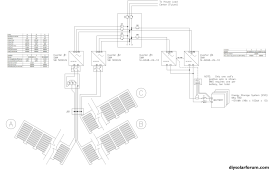jeffroboto
New Member
Hi-
I'm new around here. I've been on an internet solar power crash course on the last 48 hours and most roads lead here. So here I am. I've already learned a lot from y'all and expect that will continue.
I'm a solar newby so we should probably start with the big picture. I'm in the planning stages of a permitted (NEC 2020) off-grid system. I'll try to attach a diagram. Am I going down the any wrong roads or walking into traps? Am I missing any major components in my system? I haven't drilled down into the details on everything (e.g I haven't sized breakers, conduit, conductors, etc.). The equipment on the left side of the diagram has largely been purchased used. This drove some of the design decisions.
My intent is to maximize length in the day that solar is collected. I'm accomplishing this by facing strings SSE (-30°) and SSW (+30°). The hope is to minimize batteries. They sure are expensive! I'm currently under paneled but plan to add more. I've got space so I can use some less efficient (cheaper) ones if I find a deal.
If (BIG if) I pass the first test of a somewhat reasonable plan then I've got some questions. These may be "stupid" because I'm no electrical engineer.
-Jeff

I'm new around here. I've been on an internet solar power crash course on the last 48 hours and most roads lead here. So here I am. I've already learned a lot from y'all and expect that will continue.
I'm a solar newby so we should probably start with the big picture. I'm in the planning stages of a permitted (NEC 2020) off-grid system. I'll try to attach a diagram. Am I going down the any wrong roads or walking into traps? Am I missing any major components in my system? I haven't drilled down into the details on everything (e.g I haven't sized breakers, conduit, conductors, etc.). The equipment on the left side of the diagram has largely been purchased used. This drove some of the design decisions.
My intent is to maximize length in the day that solar is collected. I'm accomplishing this by facing strings SSE (-30°) and SSW (+30°). The hope is to minimize batteries. They sure are expensive! I'm currently under paneled but plan to add more. I've got space so I can use some less efficient (cheaper) ones if I find a deal.
If (BIG if) I pass the first test of a somewhat reasonable plan then I've got some questions. These may be "stupid" because I'm no electrical engineer.
- How to size breakers? Is it just base on wire protection? Do I need to ensure the power source (inverters) have enough capacity to trip? Or is that not a concern because the inverters can supply much larger wattage for short periods?
- Can I add batteries later? I here conflicting opinions on mixing battery age and manufacturers. I'd prefer to start with fewer and add more down the line if that is possible.
- Do I bond neutral and ground on load center shown, or on the house's load center? My lack of working NEC knowledge shows here.
- Should I run RS-485 to the Sunny Boys? Or rely on the Sunny Island to frequency shift and shutdown the PV? I don't see many examples of people using RS485. The Sunny Boys would need an additional RS485 module and hopefully it would work....
- SMA calls for at least 100ah of battery per 1000W of "nominal AC power from the AC sources in the stand alone grid." Is that only my PV sources (not the Sunny Island 12000W)? I assume this is to provide a place for the energy to go (the batteries) while the PV is shutdown if the system demand falls rapidly. Is this the case?
- I imagined mounting the gear on a strut rack with roof for shade and moisture protection. I'd place the battery rack into a NEMA enclosure and insulate it. NEC2020 Section 690 likely precludes that because the energy storage system (ESS) needs to be UL. Now I'm thinking I should install in a small shed?
-Jeff



